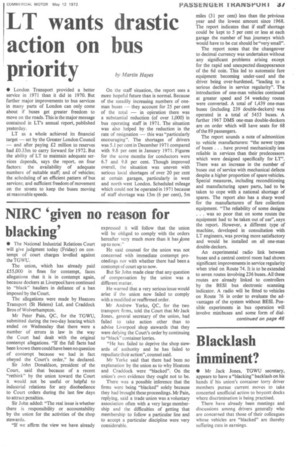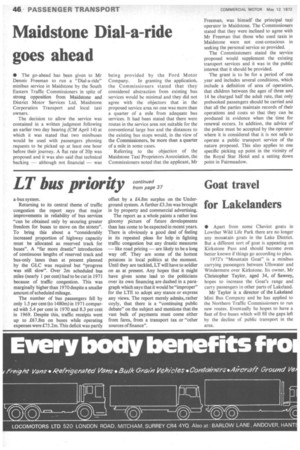LT wants drastic action on bus
Page 39

Page 48

If you've noticed an error in this article please click here to report it so we can fix it.
priority by Martin Hayes
• London Transport provided a better service in 1971 than it did in 1970. But further major improvements to bus services in many parts of London can only come about if buses get greater freedom to move on the roads. This is the major message contained in LT's annual report, published yesterday.
LT as a whole achieved its financial target — set by the Greater London Council — and after paying £2 million to reserves had £0.33m to carry forward for 1972. But the ability of LT to maintain adequate services depends, says the report, on four factors: the availability of adequate numbers of suitable staff; and of vehicles; the scheduling of an efficient pattern of bus services; and sufficient freedom of movement on the streets to keep the buses moving at reasonable speeds. On the staff situation, the report sees a more hopeful future than is normal. Because of the steadily increasing numbers of one man buses they account for 25 per cent of the total — in operation there was a substantial reduction (of over 1,000) in bus operating staff in 1971. The situation was also helped by the reduction in the rate of resignation — this was "particularly encouraging". The shortages of drivers was 5.1 per cent in December 1971 compared with 9.8 per cent in January 1971. Figures for the same months for conductors were 6.7 and 9.8 per cent. Though improved overall, the situation was uneven with serious local shortages of over 20 per cent at certain garages, particularly in west and north-west London. Scheduled mileage which could not be operated in 1971 because of staff shortage was 13m (6 per cent), 5m miles (31 per cent) less than the previous year and the lowest amount since 1968. The report indicates that if staff shortage could be kept to 5 per cent or less at each garage the number of bus journeys which would have to be cut should be "very small".
The report notes that the changeover to decimal currency was undertaken without any significant problems arising except for the rapid and unexpected disappearance of the 6d coin. This led to automatic fare equipment becoming under-used and the driver being over-burdened, "leading to a serious decline in service regularity". The introduction of one-man vehicles continued at greater speed and 54 weekday routes were converted. A total of 1,439 one-man buses (including 239 double-deckers) was operated in a total of 5453 buses. A further 1967 DMS one-man double-deckers are on order which will have seats for 68 of the 89 passengers.
The report sounds a note of admonition to vehicle manufacturers: "the newer types of buses . . have proved mechanically less reliable in services than their predecessors which were designed specifically for LT". There was an increase in the number of buses out of service with mechanical defects despite a higher proportion of spare vehicles. Special measures, including reconditioning and manufacturing spare parts, had to be taken to cope with a national shortage of spares. The report also has a sharp word for the manufacturers of fare collection equipment. "The reliability of some designs . was so poor that on some routes the equipment had to be taken out of use", says the report. However, a different type of machine, developed in consultation with LT engineers, was proving more satisfactory and would be installed on all one-man double-deckers.
An experimental radio link between buses and a central control room had shown significant improvements in service regularity when tried on Route 74. It is to be extended to seven routes involving 236 buses. All these routes are already linked to controllers by the BESI bus electronic scanning indicator. A radio will be fitted to vehicles on Route 76 in order to evaluate the advantages of the system without BESI. Possible experiments in bus operation will involve minibuses and some form of dial
LT bus priority
continued from page 37
a-bus system.
Returning to its central theme of traffic congestion the report says that major improvements in reliability of bus services "can be obtained only by securing greater freedom for buses to move on the streets". To bring this about a "considerably increased proportion of highway capacity must be allocated as reserved track for buses". A "far more drastic" introduction of continuous lengths of reserved track and bus-only lanes than at present planned by the GLC was required but "progress was still slow". Over 2m scheduled bus miles (nearly 1 per cent) had to be cut in 1971 because of traffic congestion. This was marginally higher than 1970 despite a smaller amount of scheduled mileage.
The number of bus passengers fell by only 13 per cent (to 1480m) in 1971 compared with 5.4 per cent in 1970 and 8.3 per cent in 1969. Despite this, traffic receipts went up to £67.8m on buses while operating expenses were £75.2m. This deficit was partly offset by a £4.8m surplus on the Underground system. A further £3.3m was brought in by property and commercial advertising.
The report as a whole paints a rather less gloomy picture of future developments than has come to be expected in recent years. There is obviously a good deal of feeling in its repeated pleas for help in fighting traffic congestion but any drastic measures — like road pricing are likely to be a long way off. They are some of the hottest potatoes in local politics at the moment. Until they are tackled, LT will have to soldier on as at present. Any hopes that it might have given some lead to the politicians over its own financing are dashed in a paragraph which says that it would be "improper" for the LTE to adopt any stance or express any views. The report merely admits, rather coyly, that there is a "continuing public debate" on the subject and mentions that the vast bulk of payments must come either from fares, from a transport tax or "other sources of finance".
















































































































































































































